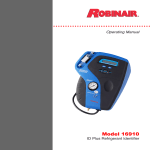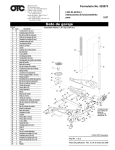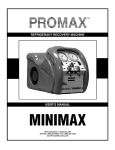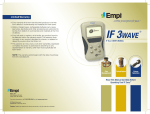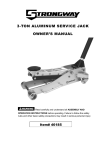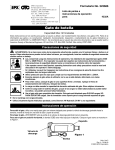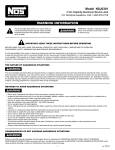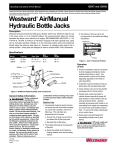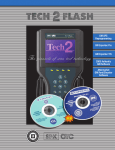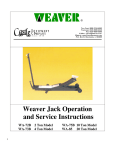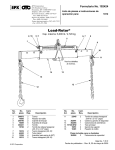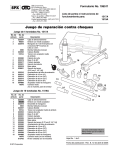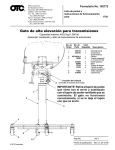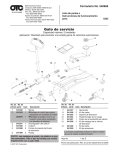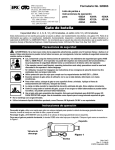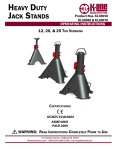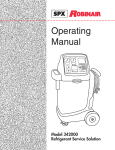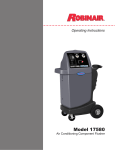Download Service Jack
Transcript
Form No. 107191 SPX Corporation 655 Eisenhower Drive Owatonna, MN 55060-0995 USA Phone: (507) 455-7000 Tech. Serv.: (800) 533-6127 Fax: (800) 955-8329 Order Entry: (800) 533-6127 Fax: (800) 283-8665 International Sales: (507) 455-7223 Fax: (507) 455-7063 Parts List and Operating Instructions for: 1727 Service Jack Max. Capacity: 2 Tons Application: Designed to lift a wide range of motor vehicles. Item No. This parts list covers OTC No. 1727 Service Jacks stamped with a date code of 109286 and later. (The date code can be found on a silver plaque located inside the frame rail above the pump.) This date code indicates the model of your jack. When you receive a repair parts kit, parts for all models will be included. Use only the parts for your jack; discard the other parts. Saddle Low Point: Saddle High Point: Lifting Range: Handle Length: 1 2 3 4 5 6 7 8 9 10 11 12 13 14 15 16 17 18 19 20 21 22 23 33/4 in. 221/2 in. 183/4 in. 48 in. 5 1 2 3, 4 (parts list on back of this sheet) 6 7 21 Part No. Qty. Description 501238 1 Handle Ass'y (not shown) 12368 1 Hex Hd. Cap Screw (3/8-16) 509167 1 U-joint 10549 1 Roll Pin 501294 1 Hydraulic Ass'y (see back) 502032 1 Decal 501237 1 Saddle 217176 1 Cotter Pin (1/8-2") 501800 2 Front Wheel 15953 2 Washer (3/4") 14855 6 Retaining Ring (3/4") 501814 2 Anchor Pin 513781 2 Spring 501394 1 Rod 501803 2 Spacer Bushing 501288 2 Caster 10252 2 Lockwasher (3/4") 10397 2 Hex Nut (3/4") 501818 4 Spacer 501805 4 Bolt (5/8-11 x 1") 501817 1 Grease Fitting (not shown) 501401 1 Load Block 10236 2 Washer Parts Included but not Shown 501234 1 Pump Roller 516675 1 Groove Pin 19, 20 8 l 17, 18 23 16 14, 15, 11 12, 13 22, 11 10, 11 © SPX Corporation Sheet No. 1 of 2 Issue Date: Rev. F (9-18-03) 9 Parts List & Operating Instructions Form No. 107191, Back of Sheet 1 of 2 No. 501294 Hydraulic Assembly 21 20 19 1 Item No. Part No. Qty. Description 2 1 512958 1 Rod Assembly j 501351 j 501299 j 10913 =j 201433 =j 509133 j 221278 sj 501804 1 1 1 1 1 1 1 sj 1 1 1 1 1 1 Retaining Ring Retaining Wire O-ring Retaining Ring U-Cup Seal Plug Ball Seat Screw (torque to 130 in.•lbs.) Ball O-ring Relief Screw Pump Rod U-cup Pump Tube (torque to 75 ft.•lbs.) Crush Washer Check Valve Brass Backup Ring Wear Ring O-ring Gland (includes items 5, 6, & 18) 2 3 4 5 6 7 9 3 4 5 10 11 12 13 14 15 6 18 7 Note: Previous part nos. 509131 & 509132 have been replaced by Item 18 (516432). 9, 10 11 12 17 13 16 15 14 16 17 18 19 20 21 12223 10268 sj 508931 501354 j 501397 501355 sj j 501400 221281 =j 516432 j 501298 j 14739 501300 1 1 1 1 1 1 Parts marked with an asterisk (j) are included in Seal Kit No. 501816. Parts marked with a triangle (s) are included in Pump Release Valve Repair Kit No. 501235. Parts marked with a dagger (=) are included with Item No. 1 – Piston Rod Assembly No. 512958. Shaded areas reflect the last revisions made to this document. When you receive a repair parts kit, parts for all models will be included. Use only the parts for your jack; discard the other parts. Bleeding Air from the System Air can accumulate within a hydraulic system during shipment, or if the oil supply runs too low. This entrapped air causes the jack to respond slowly or feel “spongy.” The following procedure bleeds air from the system. 1. Remove the jack from service, and place it on a level surface. 2. Open the release valve by turning the handle all the way counterclockwise (CCW). 3. Pump the handle six full strokes. 4. Close the release valve by turning the handle all the way clockwise (CW). 5. Pump the handle until the lift arm is fully extended. 6. Lower the lift arm by turning the handle all the way counterclockwise (CCW). 7. Test the jack for normal operation. If the lift pad doesn’t rise to the correct height, repeat Steps 2-6. If this doesn’t solve the problem, call the OTC Technical Services Dept. at (800) 533-6127. Parts List & Operating Instructions Form No. 107191 Safety Precautions CAUTION: To prevent personal injury and damage to equipment, • Read, understand, and follow all instructions, including ASME PALD Part 10 for service jacks. If the operator cannot read English, operating instructions and safety precautions must be read and discussed in the operator’s native language. – Si el operador no puede leer inglés, las instrucciones de operación y las precauciones de seguridad deberán leerse y comentarse en el idioma nativo del operador. – Si l’utilisateur ne peut lire l’anglais, les instructions et les consignes de sécurité doivent lui être expliquées dans sa langue maternelle. • Before using the service jack to lift a vehicle, refer to the vehicle service manual to determine recommended lifting surfaces on the vehicle chassis. • • Wear eye protection that meets ANSI Z87.1 and OSHA standards. • • A load must never exceed the rated lifting capacity of the jack. • Use the jack for lifting purposes only. Stay clear of a lifted load. Place support stands under the axles before working on the vehicle. Inspect the jack before each use; do not use the jack if it’s damaged, altered, or in poor condition. Take corrective action if any of the following conditions are found: cracked or damaged housing; excessive wear, bending, or other damage; leaking hydraulic fluid; scored or damaged piston rod; loose hardware; modified or altered equipment. Use the jack on a hard, level surface. The jack must be free to roll without any obstructions while lifting or lowering the vehicle. The wheels of the vehicle must be in the straight-ahead position, and the hand brake released. • Center the load on the jack saddle. Off-center loads can damage seals and cause jack failure. Lift only dead weight. • • • • Do not use blocks or other extenders between the saddle and the load being lifted. Do not modify the jack or use adapters unless approved or supplied by OTC. Lower the jack slowly and carefully while watching the position of the jack saddle. Use only automatic transmission fluid. The use of alcohol, hydraulic brake fluid, or transmission oil could damage seals and result in jack failure. This guide cannot cover every situation, so always do the job with safety first. Operating Instructions Setup 1. Loosen the thumb screw on the front of the handle socket. 2. Grease the socket opening. Insert the handle. 3. Torque the thumb screw to 150–200 in. lbs. Operation 1. Close the release valve by turning the handle clockwise (CW) as far as it will go. 2. Position the jack under the vehicle. IMPORTANT: Use the manufacturer’s recommended lifting points on the chassis. 3. Pump the jack handle to raise the saddle to the contact point. 4. Check the placement of the jack; the load must be centered on the jack saddle. IMPORTANT: Avoid wheel obstructions such as gravel, tools, or uneven expansion joints. 5. Finish lifting the vehicle by pumping the handle. Do not attempt to raise the jack beyond its travel stops. 6. Place approved support stands under the vehicle at points that will provide stable support. Before making repairs on the vehicle, lower it onto the support stands by SLOWLY and CAREFULLY turning the handle counterclockwise (CCW). © SPX Corporation Sheet No. 2 of 2 Issue Date: Rev. F (9-18-03) Parts List & Operating Instructions Form No. 107191, Back of Sheet 2 of 2 Preventive Maintenance IMPORTANT: The greatest single cause of failure in hydraulic units is dirt. Keep the service jack clean and well lubricated to prevent foreign matter from entering the system. If the jack has been exposed to rain, snow, sand, or grit, it must be cleaned before it is used. 1. Store the jack in a well-protected area where it will not be exposed to corrosive vapors, abrasive dust, or any other harmful elements. 2. Regularly lubricate the moving parts in the wheels, arm, and handle. 3. Replace the oil in the reservoir at least once per year. To check the oil level, lower the lift arm completely. Remove the rubber filler plug. Oil level should be at the bottom of the filler plug hole. If necessary, add automatic transmission fluid, and install the filler plug. IMPORTANT: The use of alcohol, hydraulic brake fluid could damage the seals and result in jack failure. 4. Inspect the jack before each use. Take corrective action if any of the following problems are found: a. cracked, damaged housing c. leaking hydraulic fluid e. loose hardware b. excessive wear, bending, other damage d. scored, damaged piston rod f. modified equipment 5. Keep warning labels and instructional decals clean and readable. Use a mild soap solution to wash external surfaces of the jack. Troubleshooting Guide Repair procedures must be performed in a dirt-free environment by qualified personnel who are familiar with this equipment. CAUTION: Inspection, maintenance, and repair procedures must be performed when the jack is free of a load (not in use). Trouble Cause Solution 1. Release valve is open. 6. Packing worn out or defective. 1. Close release valve. 2. Fill with automatic transmission fluid and bleed system. 3. Bleed system. 4. Use correct equipment. 5. Clean to remove dirt or foreign matter. Replace oil. 6. Replace packing. Jack lifts only partially 1. Too much or not enough oil. 1. Check oil level. Jack advances slowly 1. Pump not working correctly. 1. Rework pump. 2. Replace seals. (Seal kit No. 501816 is available from OTC.) Jack does not lift 2. Low/no oil in reservoir. 3. Air-locked system. 4. Load is above capacity of jack. 5. Delivery valve and/or bypass valve not working correctly. 2. Leaking seals. Jack lifts load, but doesn’t hold 1. Cylinder packing is leaking. 3. Air-locked system. 1. Replace packing. 2. Inspect valves. Clean and repair seat surfaces. 3. Bleed system. Jack leaks oil 1. Worn or damaged seals. 1. Replace seals. Jack will not retract 1. Release valve is closed. 1. Open release valve all the way counterclockwise (CCW). May be necessary to clean release valve. 1. Cylinder damaged internally. 1. Send jack to OTC-authorized service center. (Refer to OTC Form No. 104031.) 2. Replace return spring. 3. Lubricate or replace link section. 2. Valve not working correctly (suction, delivery, release, or bypass). Jack retracts slowly 2. Return spring is damaged. 3. Link section is binding.






